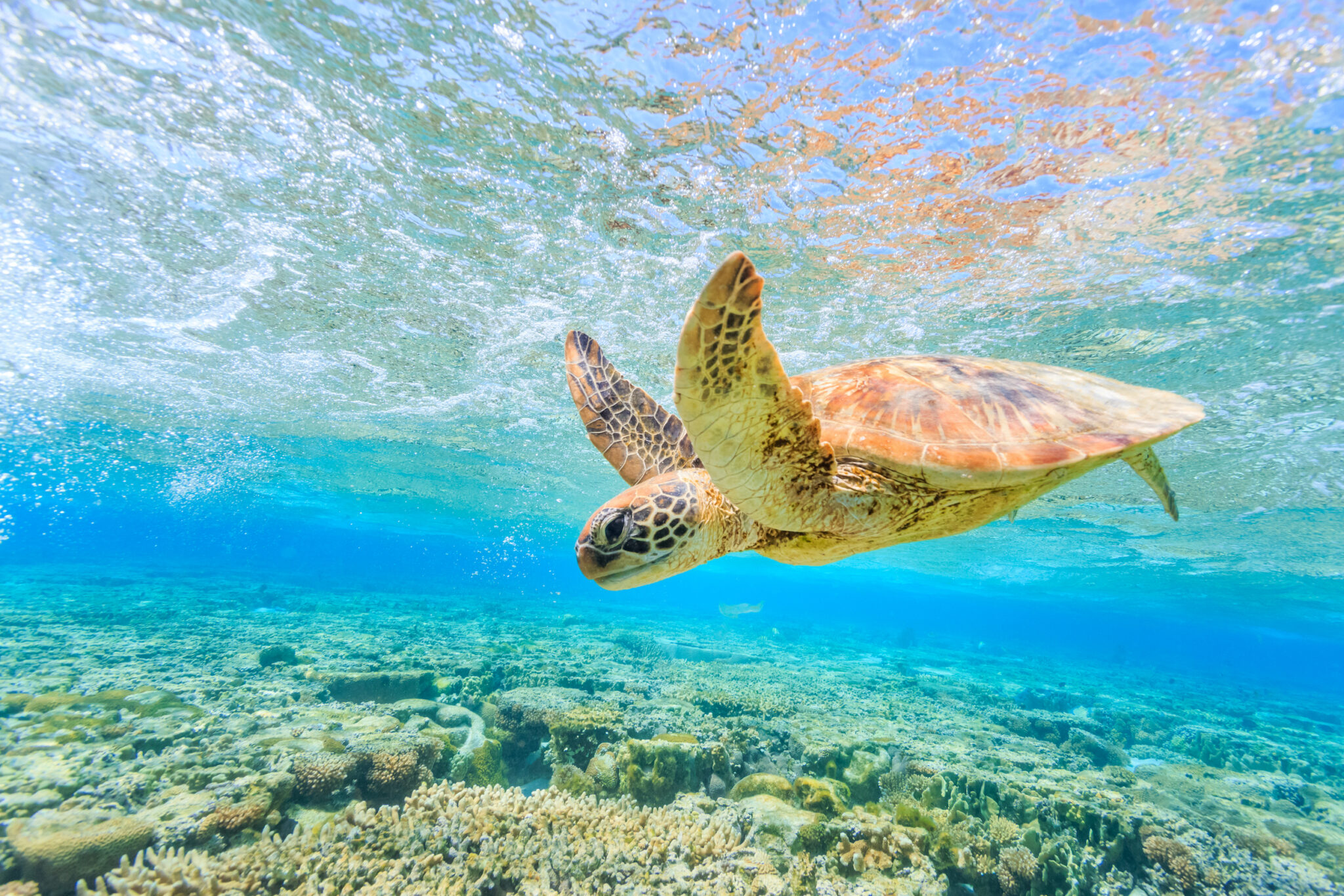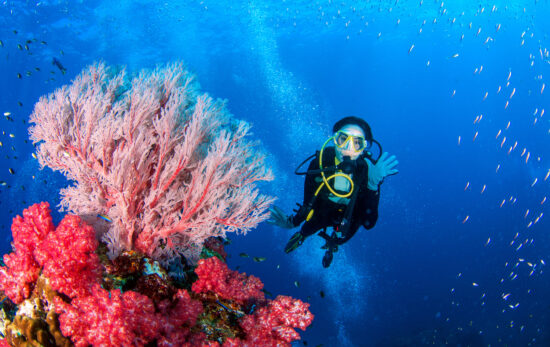Green sea turtles are marine reptiles that inhabit tropical and subtropical waters around the world. You can dive or snorkel with them in a variety of incredible locations, observing them while they feed on underwater plants or as they come up to the surface to take a breath – sometimes even while they sleep! Here you’ll find some fascinating facts about green sea turtles and details about diving and swimming with them. We hope that your respect and appreciation for these incredible ocean animals continues to grow!
Love sea turtles (and all ocean animals)?! Join our global community of Torchbearers working together to seek adventure and save the ocean.
Green Sea Turtle Facts
- Scientific Name: Chelonia mydas
- Common Name: Green sea turtles are in fact named for the greenish color of their cartilage and fat.
- Size: Besides leatherback turtles, green sea turtles are the largest sea turtles on the planet. Their shell, also known as the carapace, can reach lengths of 4.5 feet (140 centimeters) and green sea turtles can weigh up to 520 pounds (235 kilograms).
- Diet: They are predominantly herbivorous, eating mostly seagrasses and algae.
- Distribution: Green sea turtles live in all tropical and subtropical waters of the world. Some of their primary nesting sites are located in Tortuguero (Costa Rica), Oman, Florida, and Raine Island (Australia). Two subspecies of green sea turtle can be found in the Galapagos Islands and Hawaii.
- Migration: Green sea turtles perform long migrations (thousands of miles) in adulthood, moving from foraging areas (where they normally reside to feed) to breeding and nesting areas.
- Reproduction: Sexual maturity is reached at around 20 to 40 years old, varying from region to region. Mating usually takes place near the site where the female will lay her eggs, but it sometimes occurs in the open sea. Males and females come together thanks to the release of special hormones that guide the sea turtle to its partner.
- Eyesight: Green sea turtles have very poor eyesight out of the water. It can be compared to human eyesight underwater when we open our eyes without a mask.
- Threats: For green sea turtles, there are a plethora of human-caused threats, including entanglement in fishing gear, plastic and marine debris, ocean pollution, coastal development, climate change impacts on habitat, as well as poaching and the illegal trade of sea turtle eggs. Part of the population is also affected by Fibropapilloma (FP) disease that causes tumors in the eyes, mouth, soft-skin areas and internal organs.
- Current population trend: Decreasing
- Status: Endangered
Q&A About Green Sea Turtles
Where can I go diving and swimming with green sea turtles?
For just this question, we have created a list of the 11 best places to swim and dive with sea turtles!
Do sea turtles have predators?
Yes, while baby sea turtles are still in their eggs, crabs enjoy digging in with their claws. While scurrying from their nest to the sea, they can be eaten by crabs, birds and other animals. As juveniles, sea turtles might be consumed by fish in the ocean. Once these sea turtles reach adulthood, only sharks and killer whales really pose a threat (an of course humans).
How long can a green sea turtle hold its breath?
It depends. If eating or swimming, green sea turtles can hold their breath up to 30 minutes. If they are resting, these amazing animals can hold their breath for over 4 hours!
Will a female green sea turtle nest (lay eggs) more than once a year?
A female lays eggs 1 to 9 times per season (3 on average) at intervals of one or two weeks, every 3 years. Overall, green sea turtles nest in more than 80 countries.
How many eggs do they deposit into one nest?
The number of eggs laid ranges from 1 to 230. On average, green sea turtle moms lay about 110 eggs per nest. They look almost identical to ping-pong balls.
How long does it take for green sea turtle eggs to hatch?
The eggs hatch after roughly 6 to 8 weeks, but this period can vary depending on the average temperature of the nest.
How can I see a green sea turtle nesting or the babies heading to the ocean?
You’ll want to sign up for a permitted, eco-friendly tour operator that provides sea turtle observation opportunities. Check our top 10 list for more info.
How long do green sea turtles live?
Their lifespan is about 80 to 100 years!

Sea Turtle Conservation Groups
Fortunately, there are several groups of experts who have founded associations which protect these animals through research, education, training and habitat protection. For more information check out: Sea Turtle Conservancy, SEE Turtles, and Sea Turtle Preservation Society. Special thanks to Agnese Mancini from Hepca and Alessandra Sulis for their contributions to this blog article.


